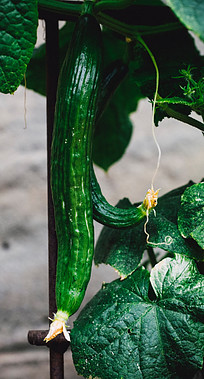
Cucumbers have been cultivated for over 3000 years now and have their origins from India. They were later taken to Europe where they became favored by Greeks and Romans. One example is Emperor Tiberius who used to demand fresh cucumbers every day. It was made more popular by Columbus through his explorations.
Cucumbers are easy to grow vegetables that need sunlight water to grow well. Once these are available, they tend to grow very fast. You can easily prepare a place to plant cucumbers in your garden; just make sure that the soil is fertile and moist and there is also a lot of sunlight.
You can prepare the soil to plant it by getting it mixed with lots of compost or animal dung. If you don’t have much space in your garden, you can go for varieties like Bush Champion and Pickle bush that can also thrive well in containers.
Flower pots, old gallons, and sacks will grow it quite well too if you can give them enough attention, water them regularly and place them where they can receive enough sunlight.
Cucumbers were officially considered like carrots, cabbage, potatoes, cauliflowers, celery, beets, and parsnips which are all “fruits of the vine” and are grown in the kitchen gardens and used in main courses in meals and not dessert fruits, and as such, are classified as vegetables.
However, they develop from the fertilization of their flowers and contain seeds just like typical fruits.
Cultivating Cucumbers
This vegetable can be planted by seed or transplanted but you have to be very careful when transplanting to avoid injuring their roots. When you plant cucumbers by seed, they will not germinate unless the temperature comes down to 60 degrees or lower.
Plant one or two cucumber seeds per hole and space them up to 36 inches apart. They do not need much attention in the garden; just ensure that they have enough moisture and heat. If they do not get enough water, the yield may be low.
You can plant them after harvesting spring vegetables. If you have used organic fertilizer, you will not need to apply a chemical fertilizer, but as soon as it begins to flower and fruit, you can apply a balanced soluble fertilizer.
How to Prepare Your Cucumber Site
- Make sure they are planted in an area that the sun reaches fully
- Mix compost or manure up to a depth of two inches and make sure that it well mixed into the soil
- Make sure that the soil is moist and well-drained and not soggy, and it should have a pH of 6.5 – 7.0
- Light sandy soils are suitable for planting them.

Planting Your Cucumbers
- Plant each seed one inch deep with spacing of two to three feet in-between. If you will be training them on a trellis, then a spacing of one foot apart is adequate. You can also make mounds and plant your seeds on the hills
- You can keep the soil warm and moist by covering with polythene
- After planting, you can cover with straw to keep birds and insects from picking your seeds. Be careful with the straw you used to prevent seeds from falling and becoming weed afterward
- Use a trellis for the vine to climb and also protect the fruits from staying on the moist ground.
Tips for Successful Cucumber Farming
- You can use dark plastic mulch on your cucumber bed to keep the soil moist and warm and also control weed in your cucumber garden
- Apply vertical farming by using varieties like Sweet Success and Tasty Green that can grow vertically. Vertical farming conserves space and increases yield. Also, you will find the fruits clean because they are elevated from the ground. Vertical farming of cucumber also allows for better air circulation and more sunlight on all parts of the plant.
Nurturing Your Cucumber
- Cucumbers need a lot of water to grow well. You have to water them consistently morning and early evening. You can test when they need water by putting a finger into the soil, and if the dryness goes beyond the first joint of your finger, then it should be watered
- As the seedlings emerge, they should be watered more often, and once they start fruiting, water availability should be more. Keep much of the water off the leaves to prevent disease infections
- Using a liquid fertilizer on your plant is a good idea. You can apply it at planting, a week after they bloom and once every three weeks. Spray it directly on the soil and on the plants
- If you will be using trellises, set them up early, so the seedlings can begin to train on them early, and also prevent damage to the plants.
Pests and Diseases
- Common pests that attack cucumber include cucumber beetles, aphids, and spider mites. It is best to keep off beetles by covering them with floating covers once the seedlings emerge or after transplanting. This will reduce the damage by the beetles or prevent the moths from laying their eggs on them. However, the covers have to be taken off once they blossom to allow for pollination. You can also apply pesticides for pest control.
- There are other diseases of cucumber to watch out for. They include bacterial wilt, anthracnose, downy and powdery mildews, mosaic, and scab disease. You should always go for disease-resistant varieties and try to avoid too much wetness on the leaves.
Harvesting and Storing Your Cucumbers
- Cucumbers taste better when they are harvested young. They are usually ready for harvest when they are about six to eight inches long. If they are meant for pickling, then three to six inches long is adequate
- It is better to harvest them when their seeds are still tender. The cucumbers should look uniformly green, firm, and crisp
- To pick your cucumbers, just use a knife of clipper and cut the stem just above the fruit
- You can wrap them in plastics and store them properly in the refrigerator. If well stored, they can keep for up to ten days.
Final Words
You can make cucumbers a regular part of your diet by growing them in your garden. You can plant them by seed or transplant them. They perform really well when they get enough moisture and exposure to sunlight. Do not attempt to store them for too long after harvest and keep them refrigerated.
I hope you enjoyed reading these articles and if you have any questions or something to share about these articles, please leave your comments below. Thank you so much and happy gardening.

Nath
Cucumber is always a fascinating plant for me. Honestly, I really appreciate everything you have shared here with us. To be honest, getting to grow cucumber in a garden would be great especially the fact that we have it in limited supply in our area. Thanks for the detailed information in here. Surely a worthy read
admin
Hi Nath,
Thank you so much for reading my articles about how to grow Cucumber in a garden. It’s true at a time like this ” at pandemic” we really need to grow our own veggies in our place, and we are very sure that we have fresh food in our table. Again, thank you so much and best wishes to you and all your family.
Joyce
Suz
I love cucumbers a lot and one of the reason is because it has a lot of helath benefits and I also use it for my skin too. I just had the thought that maybe I could start growing mine in my mum’s garden as it would be nice to have.mine than buying Everytime. It doesn’t seem so hard to grow. I will be back with my feedback here. Thank you!
admin
Hi Suz,
Thank you so much for dropping by on my website site and reading my articles about How to Grow Cucumber in a Garden. Yes, it is true it is better to grow our own veggies and have it fresh in our table and have much fun while growing them. Yes, sure see you next. I wish you all the best and all of your family too.
Joyce